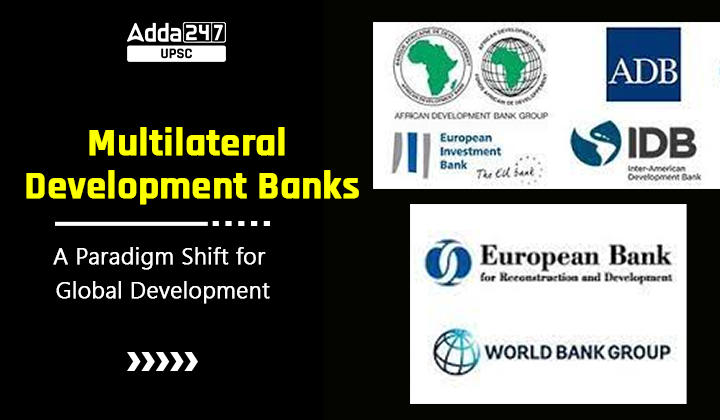Table of Contents
Multilateral Development Banks: Multilateral Development Banks (MDBs) play a pivotal role in fostering global development by providing financial and technical assistance to countries for various projects. Recently, a G20 expert panel has proposed significant reforms for MDBs like the World Bank and the Asian Development Bank. This article explores the reasons behind the proposed reforms, the nature of traditional lending practices, and the recommendations put forth by the expert group.
Multilateral Development Banks
Multilateral Development Banks are institutions comprising both developed and developing countries, collaborating to fulfill lending obligations that facilitate developmental objectives. These banks finance projects spanning sectors like transport, energy, urban infrastructure, and waste management. Developed nations contribute to the lending pool while developing nations borrow to fund crucial development projects.
Need for Reforms, Addressing Global Challenges
The G20 expert group emphasizes the urgency of reforms within MDBs, citing the climate crisis as a key driver. Despite global awareness of necessary measures to mitigate climate change, the group argues that mechanisms to implement these changes on a global scale, particularly in emerging markets and developing economies (EMDEs), are lacking. The proposed reforms aim to equip MDBs to effectively address global challenges.
Sustainable Development Goals
Traditionally, MDBs have financed individual projects, but the proposed reforms advocate for a shift towards prioritizing programs with sectoral focus and long-term transformation plans. The emphasis is on aligning operations, both financial and analytical, with the sustainable development goals (SDGs) identified by national governments. This shift aims to enhance the impact of MDBs by ensuring a more comprehensive and strategic approach.
Private Sector Engagement, A Central Theme
The expert group recommends bringing private sector engagement to the forefront of MDB operations. It calls for breaking away from the limited operational interaction between private and sovereign financing arms. Recognizing the critical role of the private sector in achieving development goals, the reforms aim to foster greater collaboration and risk-sharing between MDBs and private entities.
Coordination and Involvement
To mitigate coordination failures, the expert group underscores the importance of greater involvement of national governments. The call is for the development of “home-grown unified visions” that encompass goals, policies, investments, and financing. This coordination is seen as crucial for the success of MDBs in addressing the complex challenges faced by both domestic and international stakeholders.
Impact on Private Sector Perception
The existing perception of MDBs as bureaucratic and risk-averse has hindered private sector engagement. The expert group acknowledges this and proposes reforms to make MDBs more attractive to the private sector. This includes a call for MDBs to take on more risk, especially credit and policy risk, and manage it effectively. The objective is to reverse the trend of “disappointingly low” private financial flows to EMDEs and enhance private sector involvement in financing.
Traditional Lending Practices in India A Case Study
Examining the traditional lending practices of MDBs in a country like India provides valuable insights. The World Bank, Asian Development Bank, Asian Infrastructure Investment Bank, and European Investment Bank have played crucial roles in financing key infrastructure projects in India. The sectors receiving significant funding include public administration, agriculture, transport, energy, and urban infrastructure.
World Bank in India Case Study
Since its establishment in 1944, the World Bank has committed substantial funding to India, focusing on projects in the public administration, agriculture, and transport sectors. The long-term nature of the projects reflects the developmental commitment of the World Bank to India’s growth.
Asian Development Bank in India
The Asian Development Bank, formed in 1969, has committed significant assistance to India, particularly in the transport, energy, and urban infrastructure sectors. The ADB’s contributions highlight the collaborative efforts to address diverse development needs in a rapidly evolving economy.
Asian Infrastructure Investment Bank in India
The relatively new Asian Infrastructure Investment Bank, established in 2016, has rapidly approved financing for various sectors in India, including transport, energy, and economic resilience. This underscores the evolving landscape of MDBs and their role in addressing contemporary challenges.
European Investment Bank in India
Established in 1958, the European Investment Bank has signed off on numerous projects in India, with a focus on the transport and energy sectors. This demonstrates the diverse sources of funding contributing to India’s development and the importance of collaboration between MDBs.
Conclusion
In conclusion, the proposed reforms for Multilateral Development Banks mark a significant shift in approach, emphasizing coordination, sustainability, and private sector engagement. The case study of India showcases the historical collaboration between MDBs and the country’s developmental priorities. As the global landscape evolves, these reforms aim to ensure that MDBs are equipped to address the complex challenges of the 21st century and contribute meaningfully to sustainable development goals. The success of these reforms will depend on the commitment of member nations, effective coordination, and a willingness to embrace innovation and risk in the pursuit of a better future for all.



 TSPSC Group 1 Question Paper 2024, Downl...
TSPSC Group 1 Question Paper 2024, Downl...
 TSPSC Group 1 Answer key 2024 Out, Downl...
TSPSC Group 1 Answer key 2024 Out, Downl...
 UPSC Prelims 2024 Question Paper, Downlo...
UPSC Prelims 2024 Question Paper, Downlo...
